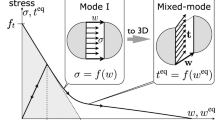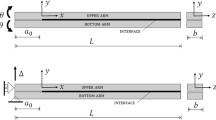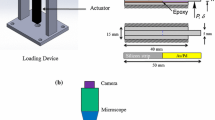Abstract
A traction-separation relation to model the fracture process is presented. The cohesive law captures the linear elastic and softening behaviour prior to fracture. It also allows for different fracture parameters, such as fracture energy, strength and critical separation in different mode mixities. Thus, the fracture process in mode I (peel), in mode II (shear) or in mixed mode (a combination of peel and shear) can be modelled without the limitation of a common fracture energy in peel and shear. Examples are given in form of FE- implementations of the normalised cohesive law, namely for the Unsymmetrical Double Cantilever Beam (UDCB) specimen and the Mixed-mode double Cantilever Beam (MCB) specimen. Both specimens are adhesively bonded and loaded in mixed-mode.
Similar content being viewed by others
References
Andersson T, Stigh U (2004) The stress-elongation relation for an adhesive layer loaded in peel using equilibrium of energetic forces. Int J Solid Struct 41:413–434
Barenblatt GI (1962) The mathematical theory of equilibrium cracks in brittle fracture. Adv Appl Mech 7:55–129
Chai H (2003) Interfacial mixed-mode fracture of adhesive bonds undergoing large deformation. Int J Solid Struct 40:6023–6042
Chai H, Chiang MYM (1996) A crack propagation criterion based on local shear in adhesive bonds subjected to shear. J Mech Phys Solid 44(10):669–1689
Chen CR, Kolednik O, Heerens J, Fischer FD (2005) Three-dimensional modelling of ductile crack growth: cohesive zone parameters and crack tip triaxiality. Eng Fract Mech 72:2072–2094
Elices M, Guinea GV, Gómez J, Planas J (2002) The cohesive zone model: advantages, limitations and challenges. Eng Fract Mech 69:137–163
Högberg JL (2004) Mechanical behaviour of single-layer adhesive joints—an integrated approach. Thesis for the degree of Licentiate of Engineering, Chalmers University of Technology, Göteborg, Sweden. ISSN 1650-8912 2004:3. (Available at www.his.se/MechMat)
Högberg JL, Stigh U (2006) Specimen proposals for mixed mode testing of adhesive layer. Eng Fract Mech 73:2541–2556
Kafkalidis MS, Thouless MD (2002) The effect of geometry and material properties on the fracture of single lap-shear joints. Int J Solid Struct 39:4367–4383
Leffler K, Alfredsson KS, Stigh U (2006) Shear behaviour of adhesive layers. Int J Solid Struct (Accepted for publication)
Li S, Thouless MD, Waas AM, Schroeder JA, Zavattieri PD (2006) Mixed-mode cohesive-zone models for fracture of an adhesively bonded polymer–matrix composite. Eng Fract Mech 73:64–78
Madhusudhana KS, Narasimhan R (2002) Experimental and numerical investigations of mixed mode crack growth resistance of a ductile adhesive joint. Eng Fract Mech 69(7):865–883
Pantano A, Avrill RC (2004) A mesh-independent interface technology for simulation of mixed-mode delamination growth. Int J Solid Struct 41:3809–3831
Pardoen T, Ferracin T, Landis CM, Delanny F (2005) Constraint effects in adhesive joint fracture. J Mech Phys Solid 53:1951–1983
Rice JR (1968) A path independent integral and the approximate analysis of strain concentration by notches and cracks. J Appl Mech 35:379–386
Roy S, Shiue F-W (2003) Coupled hygrothermal cohesive-layer constitutive model for simulating debond growth. Poly Poly Composit 11(8):633–648
Roy YA, Narasimhan R, Arora PR (1999) An experimental investigation of constraint effects on mixed mode fracture initiation in a ductile aluminium alloy. Acta Mater 47(5):1587–1596
Salomonsson K (2002) Interphase elements connection structural finite elements formulation, implementation and verification. Master thesis. Chalmers University of Technology, Göteborg, Sweden. (Available at www.his.se/MechMat)
Salomonsson K, Andersson T (2006) Modeling and calibration of an adhesive layer at the meso level. Submitted for publication.
Scheider I, Schödel M, Brocks W, Schönfeld W (2006) Crack propagation analyses with CTOA and cohesive model: comparison and experimental validation. Eng Fract Mech 73(2):252–263
Sørensen BF, Jacobsen TK (2003) Determination of cohesive laws by the J integral approach. Eng Fract Mech 70:1841–1858
Sørensen BF, Jorgensen K, Jacobsen TK, Ostergaard R (2004) A general mixed mode fracture mechanics test specimen: the DCB-specimen loaded with uneven bending moments. Riso-R-1394(EN). Riso National Laboratory, Roskilde, Denmark.
Tan H, Liu C, Huang Y, Geubelle PH (2005) The cohesive law for the particle/matrix interfaces in high explosives. J Mech Phys Solid 53:1892–1917
Tvergaard V, Hutchinson JW (1992) The between crack growth resistance and fracture process parameters in elastic-plastic solids. J Mech Phys Solid 40:1337–1397
Tvergaard V, Hutchinson JW (1996) On the toughness of ductile adhesive joints. J Mech Phys Solid 44(5):789–800
van den Bosch MJ, Schreurs PJG, Geers MGD (2006) An improved description of the exponential Xu and Needleman cohesive zone law for mixed-mode decohesion. Eng Fract Mech 73:1220–1234
Xu X-P, Needleman A (1993) Void nucleation by inclusion debonding in a crystal matrix. Model Simulat Mater Sci Eng 1(2):111–132
Author information
Authors and Affiliations
Corresponding author
Rights and permissions
About this article
Cite this article
Högberg, J.L. Mixed mode cohesive law. Int J Fract 141, 549–559 (2006). https://doi.org/10.1007/s10704-006-9014-9
Received:
Accepted:
Published:
Issue Date:
DOI: https://doi.org/10.1007/s10704-006-9014-9




